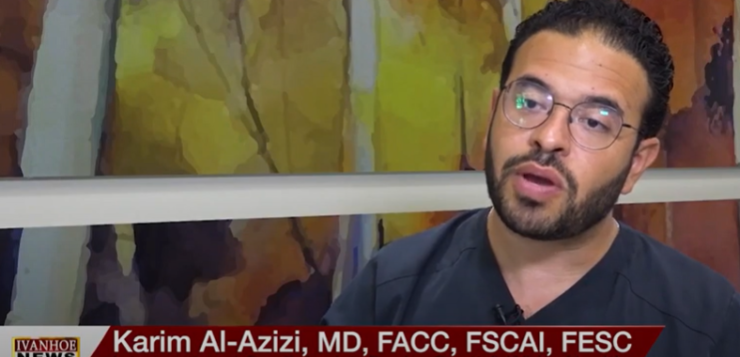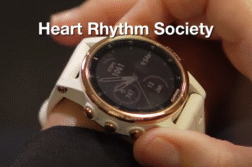Dr. Karim Al-Azizi, MD, interventional cardiologist and structural heart disease specialist at Baylor, Scott and White Health, the Heart Hospital, Plano, talks about a new way to perform cardiac catheterization.
Interview conducted by Ivanhoe Broadcast News in June 2022
What is DIPRA and what led to doing that for our patients?
AL-AZIZI: The DIPRA study is essentially evaluating a novel way of accessing the radial artery in the wrist in order to perform cardiac catheterization. What we know is that cardiac catheterization is traditionally performed through the femoral artery and the proximal radial artery now is more of a growing yet novel and not really gaining a whole lot of attention when it comes from the distal radial axis. The proximal radial artery access, although has been around for a few years now, is still in its growing phases. But distal radial remains a big question, as it is truly a novel access. So, the question has always come up is the distal radial artery access a safe access for our patients compared to the safe proximal radial? So essentially, there are two areas on the hand that we access the arteries for a heart catheterization. One is the traditional right here in the wrist. The other that we wanted to test its safety is right here in the hand in the and it’s essentially the same artery, but in a different location. So, we wanted to compare the traditional radial artery versus the distal radial artery and see if, is it safe for our patients? Do patients’ hand function change over time? We assess that at 30 days as well as one year. We were happy and privileged to present our 30-day data at a recent conference.
What’s the importance of this? Why are looking at other places to perform access?
AL-AZIZI: There has been, like, everything there is some adversity to certain accesses. For example, there is a possibility of bleeding when we go through the groin, less so with the radial artery. But with the radial artery, there is also an increased risk of these arteries getting damaged and perhaps closing down over time called radial artery occlusion. So, distal radial has been shown to have lower radial artery occlusion rates. The important clinical question that came up well, we answered the question. We know that the arteries are better, if you would access it, you put your catheter through the hand. But what about the nerves, since it’s a very small area and it’s important and it’s close to the fingers that a lot of professionals use for their day-to-day living. So, we wanted to test the hand function by using grip test grip testing as well as pinch testing, as well as a questionnaire for their day to day use and see if that would change before a procedure. Thirty days after the procedure, we took 150 patients. We put them in the arm where they used essentially their proximal radial or the regular radial as compared to the distal radial. We compared those for 30 days and we are comparing it and still looking at the outcomes for one year.
Is this more about options because you were saying, if you continue to access the artery here, there could be damage. So, if someone has to have repeated procedures, catheterizations, you now have different access points so that that patient can safely get that treatment or that care.
AL-AZIZI: Yes, correct. I mean, the importance of the radial artery, not just for the hands for the blood supply to the hand, because the blood supply to the hand is a very complicated system. Even if you lose this radial artery, it’s not the end of the world. We have proven that the other artery that supplies the hand is good enough. But the importance of this radial artery perhaps is used in patients, for example, that need or may need dialysis in the future. They use the artery for that reason. Also, as you mentioned, repeated procedures. Perhaps we know now that the radial artery is safer than going through the groin, if possible and feasible. So, if patients come in for a procedure like a heart cath and require a stent, they may require very well stents in the future. Preserving that radial artery for future reinterventions or future procedures is key. Maintaining that and keeping that radial artery is very important.
Can you talk about some of the procedures that would benefit this type of access?
AL-AZIZI: Essentially, in the literature, there has been a lot of interest from the nephrologist that tend to open AV fistulas or connections for dialysis access, as well as up to neuro interventions where brain interventions for strokes or whatever it is can be done through the distal radial artery access. So, essentially, the way we want to think about this is that all roads lead to Rome. The moment you get into the arteries and the blood vessels, you have access to the rest of the body once you get into the main artery or the aorta. It’s an entry point and an exit point. Maintaining that door and keeping that entry point open yet safe in terms of during the procedure and even following the procedure is as important as getting the access itself.
How will this benefit the patients over time, if this is proven, what’s going to be the ultimate benefit?
AL-AZIZI: With the test results, with the study results showing that it is as safe as the traditional from a hand function standpoint and it hasn’t really affected the hand function, looking at patients from different angles, whether it’s the pinch or the grip or the questionnaire that we used in our study, it is important for patients that may need or require multiple procedures, whether it’s for their heart or for any other reasons. So, if their distal radial artery can accommodate and is a good candidate for this kind of access, perhaps this may be even superior to the proximal radial in the right patient, given the fact that you may preserve the radial artery as compared to going to the conventional radial artery it is still something that we will study for the long term. We will present our one-year data, hopefully next year, same time. But at least the early signs and the early signals that we’re getting from our 30-day data shows that it is safe and will be helpful for our patients.
Is there anything else that you would want to mention for consumers to know about this study?
AL-AZIZI: No, I think this was a study that was done here at the heart hospital. We are very proud of it. Our operators, our cath lab, our team were all believed in the question in the clinical question. So, it is something that will grow over time, will add to the body of the literature. I want to thank the team as well as the patients that agreed to participate in this important clinical trial that might have and will help a lot of patients around the world.
END OF INTERVIEW
This information is intended for additional research purposes only. It is not to be used as a prescription or advice from Ivanhoe Broadcast News, Inc. or any medical professional interviewed. Ivanhoe Broadcast News, Inc. assumes no responsibility for the depth or accuracy of physician statements. Procedures or medicines apply to different people and medical factors; always consult your physician on medical matters.
If you would like more information, please contact:
Deke Jones
(214) 820-6722
Sign up for a free weekly e-mail on Medical Breakthroughs called First to Know by clicking here




